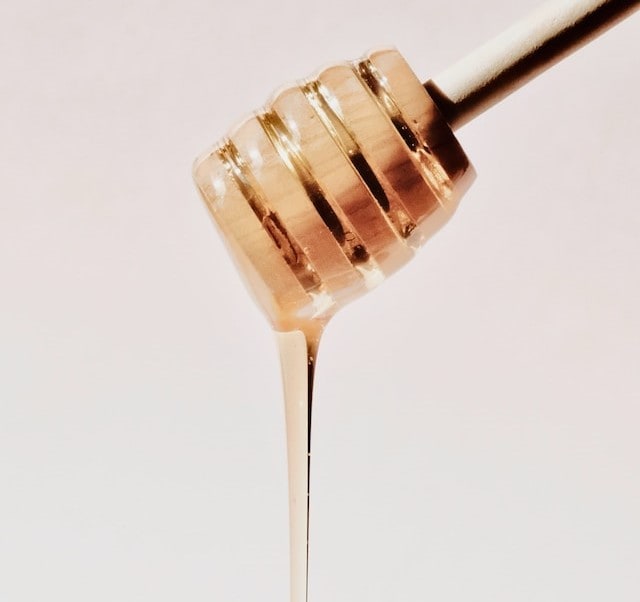Highly coveted by food connoisseurs worldwide, Sourwood Honey is renowned as the best-tasting honey.
In this blog post, we share with you the source for Sourwood Honey, its qualities, health benefits, and other uses.
What is Sourwood Honey?
Sourwood honey is that variety produced by bees from the pollen and nectar of flowers of a sourwood tree. It is a monofloral variety taken and produced solely from sourwood tree blossoms.

In the US, Americans tag this variety as something unmatched in quality and taste.
Contrary to its name, the honey itself has a spicy flavor that is impossible to find in other honey varieties. It is a rare treat and a specialty prized for its true distinctiveness.
It has a floral and remarkable taste, which first-time tasters lovingly noted. Its unique aroma is a combination of cinnamon, cloves, and anise.
Some take on an ultralight to light amber color. Others come in a medium amber color, with lavender hues that slowly darken to a dusky straw as they age.
The texture is liquid and smooth, that is almost buttery and melts on your tongue. It has a bold, complex taste, with hints of maple and a mild, slightly spicy caramel flavor. It has a persistent and pleasant aftertaste that is reminiscent of gingerbread.
This particular honey variety is sweeter than orange blossom honey and wildflower honey. Among the many kinds of honey, the closest it is comparable to is the rare Tupelo honey.
Sourwood rarely crystallizes unless it has been stored for a while, but it is still a slow kind of granulation.

Scarcity of Sourwood Honey in the United States
Sourwood honey products are often hard to find as nectar flow is inconsistent from year to year. Primarily, it is because of a lack of habitat. The source of this honey is hugely concentrated only in mountains and uneven terrain.
There is currently a very small number of sourwood trees growing, and poor environmental conditions threaten them. Plus, it has a short blooming season that is very sensitive to rainfall and lower-than-normal temperatures.
Another factor is that the trees need adequate sunlight in order to produce flowers. Sourwood trees grow to only about 30-60 feet tall. Taller trees surround them, which limits the tree from producing abundant flowers.
Making matters worse, a lot of lands where this plant grows have been deforested over the years. Land development is dramatically reducing the once impressive stance of the sourwood tree. It affects the amount of sourwood honey available to the public.
Due to these reasons, Sourwood honey has been recognized by the Ark of Taste. The Ark is an international catalog of sustainably produced foods from an ecologically distinct area. The foods making it into the catalog have a certain uniqueness in taste and are threatened by industrial standardization. In an effort to cultivate consumer demand, which is a key to agricultural conservation, only the best-tasting yet endangered foods are included in the Ark list.
Sourwood honey got its name from the acidic leaves of the Sourwood trees.
The Sourwood Tree
The Sourwood tree (Oxydendrum arboreum) came from the Greek words oxy (acid) and dendron (tree). It grows abundantly in the upland forests of the Blue Ridge and the Appalachian Mountains in North Carolina, North Georgia, and South Carolina in the United States.
Other names for this tree are Lily of the Valley, Appalachian Lily, Sour gum, or Sorrel tree. With its leaves in vibrant color, it makes a scenic picture when grown together with black gum.

This USA-native tree starts to bloom around mid-June and lasts in less than a month. It has long, drooping clusters of sweet-smelling white, bell-shaped flowers called “angel fingers.”
Sourwood flowers are highly fragrant, which attracts honeybees and are important sources of honey.
There is only a narrow 3-4 week window where bees can gather nectar. Thus, the timing of bringing the hives should be perfect. It is another reason why this honey is rare.
Pure sourwood honey underwent meticulous beekeeping to ensure avoidance of dilution with other nectars. Notably, some plants like tulip poplar bloom around the same time as the sourwood blossoms.
If fortunate enough, there are years when the weather conditions are favorable that the tree produces nectars in large quantities. Hence, there is a lot of harvests for the honeybees to collect and for the beekeepers to sell.
However, most of the time, when beekeepers made a great honey production last year, most probably this year would not be as bountiful.
Components and Benefits of Sourwood Honey
Sourwood honey is excellent in preventing bacterial growth with its anti-bacterial properties. It also has anti-inflammatory and antioxidant properties, helps with allergies, and treats wounds or skin conditions.
Besides having the usual health benefits of any other kind of honey, Sourwood honey is extraordinary in regards to its intense antioxidant power.
Antioxidants fight free radicals, thus preventing cell damage, and may prevent serious illnesses like heart disease and cancer.
Generally true, conventional wisdom says that darker honey contains more antioxidants than lighter ones. Sourwood honey, on the other hand, is the exception. It has greater antioxidant content than even Buckwheat or Manuka honey.
In addition to being delectably good, this honey variety is even better for your health. It is also a good choice to battle colds, coughs, and sore throats and can be palatable when mixed into your herbal tea.

What is Sourwood Honey Good For?
The distinctive honey flavor of sourwood is irresistible on just about anything.
People have been using this honey as a healthy sugar substitute. Due to its sweetness, use only 3/4 cup of honey for every 1 cup of sugar.
For serving suggestions, incorporate it into your hot tea or a cold smoothie. Or, smother it on hot cornbread, cupcakes, muffins, pancakes, or waffles. Better yet, drench your fruits, oatmeal, cereal, granola, biscuits, or yogurt in this honey.
Perfectly paired with Southern cooking and menu, you can also add this to make your own honey mustard or barbecue sauces.
You can also drink a “switchel” like how the Appalachians do it for hot summer haymaking days. Mix half a cup of honey and half a cup of cider vinegar and store in a jar. When in need of a refreshing drink, simply add four teaspoons of this mixture to a dipper of water.
These are just a few ways for you to enjoy it!
Where Can You Buy Sourwood Honey?
One doesn’t have to go to North Carolina to enjoy sourwood honey at its best. Though rare, some grocery stores and supermarkets have these items in their stocks.
Online, you can find sourwood honey all over the web in various e-commerce stores. You can even order one from Amazon.com. You can check the product information and customer reviews to assuage your doubts about its purity.
- The Savannah Bee Flute Classic is our Number One gift because of its simple elegance.
- Gluten Free and Kosher Certified
- Bold, complex, with hints of maple and spice.
- We package a single 20oz flute jar of Savannah Bee honey in a beautiful gift box that features the honey without distraction. Select your honey variety and send this unforgettable gift!
- The Savannah Bee Flute Classic is our Number One gift because of its simple elegance.
- Gluten Free and Kosher Certified
- Bold, complex, with hints of maple and spice.
- We package a single 20oz flute jar of Savannah Bee honey in a beautiful gift box that features the honey without distraction. Select your honey variety and send this unforgettable gift!
Fun Facts
Best Honey in the World
Did you know that Sourwood Honey has been hailed twice as the best honey in the world?
Yes, you read that correctly!
In 2005 and 2007, it was hailed as “The Best Honey in the World” by the Apimondia World Honey Show, a bi-annual global conference for beekeepers and honey enthusiasts.
The Sourwood Festival
Every August, thousands of people flock to Black Mountain, North Carolina, as it hosts the Sourwood Festival.
The celebration showcases the beautiful Appalachian native Sourwood tree and its one-of-a-kind honey.
You are sure to find on this occasion some of the locals’ praise-worthy pure and raw Sourwood Honey.

